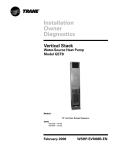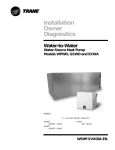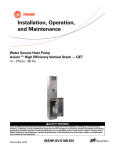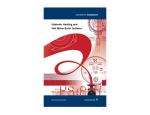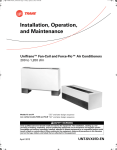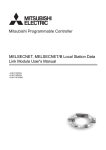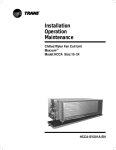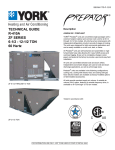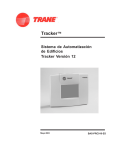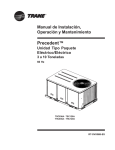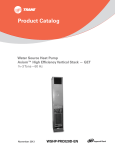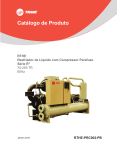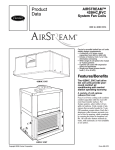Download Trane WPHF User's Manual
Transcript
Installation Owner Diagnostics Extra High Efficiency Water-Source Heat Pump Models WPVJ and WPHF Models “A” and later Design Sequence WPVJ 018-072 – 60 HZ WPHF 021-057 – 60 HZ WSHP-SVX04A-EN Notice NOTICE: Warnings and Cautions appear at appropriate sections throughout this manual. Read these carefully. WARNING -Indicates a potentially hazardous situation which, if not avoided, could result in death or serious injury. CAUTION -Indicates a potentially hazardous situation which, if not avoided, may result in minor or moderate injury. It may also be used to alert against unsafe practices. CAUTION -Indicates a situation that may result in equipment or property-damage-only accidents. Important! Equipment is shipped FOB (Free on Board) at the manufacturer. Therefore, freight claims for damages against the carrier must be initiated by the receiver. NOTICE: Unit contains HCFC (R-22) Refrigerant Instructions! Section 608, Paragraph C of the 1990 Clean Air Act states: Effective July 1, 1992, it shall be unlawful for any person, in course of maintaining, servicing, repairing, or disposing of an air conditioning system, to knowingly vent or release any CFC or HCFC refrigerant. Minimal releases (air purges or refrigerant hoses) associated with good faith attempts to recapture or recycle are exempt from the ban on venting. Responsible Refrigerant Practices! Trane believes that responsible refrigerant practices are important to the environment, our customers, and the air conditioning industry. All technicians who handle refrigerants must be certified. The Federal Clean Air Act (Section 608) sets forth the requirements for handling, reclaiming, recovering and recycling of certain refrigerants and the equipment that is used in these service procedures. In addition, some states or municipalities may have additional requirements that must also be adhered to for responsible management of refrigerants. Know the applicable laws and follow them. © 2003 American Standard Inc. All rights reserved. WSHP-SVX04A-EN Contents Installation/Startup/Commissioning WSHP-SVX04A-EN 4 Pre-installation Checklist 4 General Information 5 Dimensions/Weights 6 Installation Instructions 14 Electrical Requirements 20 Pre-Startup Checklist 25 Startup/Commissioning 26 Sequence of Operation 26 Operating Pressures 27 Startup Checklist & Log 30 Maintenance 31 Warranty Information 32 Troubleshooting Checklist 33 Unit Wiring 35 3 Pre-installation Checklist WARNING Fiberglass Wool! Product contains fiberglass wool. Disturbing the insulation in this product during installation, maintenance or repair will expose you to airborne particles of glass wool fibers and ceramic fibers known to the state of California to cause cancer through inhalation. Glass wool fibers may also cause respiratory, skin or eye irritation. Jobsite Inspection Always perform the following checks before accepting a unit: 1. Verify that the nameplate data matches the data on the sales order and bill of lading (including electrical data). 2. Verify that the power supply complies with the unit nameplate specifications. 3. Visually inspect the exterior of the unit, for signs of shipping damage. Do not sign the bill of lading accepting the unit(s) until inspection has been completed. Check for damage promptly after the unit(s) are unloaded. Once the bill of lading is signed at the jobsite, the unit(s) are now the property of the SOLD TO party and future freight claims MAY NOT be accepted by the freight company. 4. Verify that the refrigerant charge has been retained during shipment by use of gauges. Schrader taps are located external to the cabinet on the 1 1/2-ton through 6-ton equipment. 5. After assuring that charge has been retained, reinstall the schrader caps to assure that refrigerant leakage does not occur. WARNING Microbial Growth! Wet interior unit insulation can become an amplification site for microbial growth (mold), which may cause odors and damage to the equipment and building materials. If there is evidence of microbial growth (mold) on the interior insulation, the insulation should be removed and replaced prior to operating the system. Jobsite Storage This unit is intended for indoor use only. To protect the unit from damage due to the elements, and to prevent possible IAQ contaminant sources from growing, the unit should be stored indoors. If indoor storage is not possible, the following provisions for outdoor storage must be met: 1. Place the unit(s) on a dry surface or raise above the ground to assure adequate air circulation beneath the unit. 2. Cover the unit(s) with a water proof tarp to protect them from the elements. 3. Make provisions for continuous venting of the covered units to prevent moisture from standing on the unit(s) surfaces. Wet interior unit insulation can become an amplification site for microbial growth (mold) which has been determined to be a cause of odors and serious health related indoor air quality problems. 4. Store refrigeration units units in the normal UP orientation to maintain oil in the compressor. 5. Model WPHF units should not be stacked more than three high. Do not stack WPVJ units. 4 WSHP-SVX04A-EN General Information Unit Nameplate The unit nameplate is located at the front of the unit. It includes the unit model number, serial number, electrical characteristics, refrigerant charge, and other pertinent unit data. Compressor Nameplate The nameplate for the compressors are located on the compressor shell. Unit Description Before shipment, each unit is leak tested, dehydrated, charged with refrigerant and run tested for proper control operation. Water-to-Refrigerant Coils The co-axial water-to-refrigerant heat exchanger for the 1 1/2-ton through 6ton equipment is constructed of copper or cupro-nickel (option) for the water section and stainless steel for the refrigeration section. tory supplied on the ZN510 (digital) control configurations. ZN510 Controls (WPVJ and WPHF option) Units incorporating the ZN510 control option design will include a digital LonTalkTM certified control board. The control board will support such options as: random start delay, heating/ cooling status, occupied/unoccupied mode and fan/filter status. Power wiring is made at the contactor. See manual WSHP-IOP-2 for diagnostic information. Schrader Connections Connections for the low and high side of the refrigeration system are located conveniently at the equipments front panel. Sheet metal removal is not required for positive connection to the high and low schrader connections. The heat exchanger is leak tested to assure there is no cross leakage between the water and refrigerant gas. Water Connections Water connections are located at the unit front for both the WPVJ and WPHF units. They are clearly labled for supply/return connection. Sizes are as follows. Dia. Type 3/4" WPHF 021-027 - Water in/out 1" WPHF 030-072 - Water in/out 1" WPVJ - Water in/out 3/4" Drain 1/2" Desuperheater Blower/Motor The blower and motor is located inside the unit cabinet. The motor may be easily removed for service through the equipment blower access panel. Controls The control system offered to control the unit is a Basic 24 volt control, Basic 24 volt control, or TracerTM ZN510 control. A 50 VA transformer is factory supplied on the Basic 24V control configurations. A 75 VA transformer is fac- WSHP-SVX04A-EN 5 Dimensions/Weights/ Clearance Table 1: Unit weights Size Shipping Weight with pallet (lb) Shipping Weight w/o pallet (lb) WPVJ 018 249 239 024 250 240 030 298 288 036 315 305 042 324 314 048 398 388 060 439 429 072 440 430 021, 027 279 035. 040 367 356 047, 057 433 403 WARNING Improper Unit Lift! Test lift unit approximately 24 inches to verify proper center of gravity lift point. To avoid dropping of unit, reposition lifting point if unit is not level. Failure to properly lift unit could result in death or serious injury or possible equipment or property-only damage. WPHF 267 Unit Location and Clearances Locate the unit in an indoor area. The ambient temperature surrounding the unit must not be less than 45°F. Do not locate the unit in areas subject to freezing. Figure 1: Mechanical clearances - WPHF Attention should be given to service clearance and technician safety. The unit should be easily maintained or serviced in all applications. There must be enough space for service personnel to perform maintenance or repair. Provide sufficient room to make water, and electrical connection(s). Local and national codes should be followed in providing electrical power connections. See Figure 1 and 2 for mechanical clearances. Figure 2: Mechanical clearances - WPVJ 6 WSHP-SVX04A-EN Dimensions WPHF 021-057 WSHP-SVX04A-EN 7 Dimensions WPVJ 018-024 LH 8 WSHP-SVX04A-EN Dimensions WPVJ 018-024 RH WSHP-SVX04A-EN 9 Dimensions WPVJ 030-042 LH 10 WSHP-SVX04A-EN Dimensions WPVJ 030-042 RH WSHP-SVX04A-EN 11 Dimensions WPVJ 048-072 LH 12 WSHP-SVX04A-EN Dimensions WPVJ 048-072 RH WSHP-SVX04A-EN 13 Installation General Installation Checks The checklist below is a summary of the steps required to successfully install a unit. This checklist is intended to acquaint the installing personnel with procedures required in the installation process. It does not replace the detailed instructions called out in the applicable sections of this manual. 1 Remove packaging and inspect the unit. Check the unit for shipping damage and material shortage; file a freight claim and notify appropriate sales representation. Note: The vertical units have been tied to the skid by (8) shipping brackets with (16) 5/16" screws. Remove the (8) screws attached on the unit side, and (2) screws attached at the L bracket side. The unit may now be slid off of the skid. Re-attach (8) of the screws into the unit base pan. 2 3 4 Verify the correct model, options and voltage from the unit nameplate. Verify the installation location of the unit will provide the required clearance for proper operation. Remove refrigeration access panel and inspect the unit. Be certain the refrigerant tubing has clearance from adjacent parts. WARNING Hazardous Voltage! Disconnect all electric power, including remote disconnects before servicing. Follow proper lockout/tagout procedures to ensure the power can not be inadvertently energized. Failure to disconnect power before servicing could result in death or serious injury. Main Electrical 5 Verify the power supply complies with the unit nameplate specifications. 6 Inspect all control panel components; tighten any loose connections. 7 Connect properly sized and protected power supply wiring to a field-supplied/installed disconnect switch and to the unit contactor (1K1) in the unit’s cabinet control box for equipment. 8 Install proper grounding wires to an earth ground. Note: All field-installed wiring must comply with NEC and applicable local codes. Low Voltage Wiring (AC & DC) Requirements 9 Connect properly sized control wiring to the proper termination points between the thermostat/ sensor and the terminal board in the unit’s control box. Filter Installation 10 Each unit ships with 1" filters. Do not operate the unit without filters. 14 WSHP-SVX04A-EN Installation Unit Installation; WPVJ Duct collars are provided for the WPVJ equipment. The duct system and diffusers should be sized inaccordance with ASHRAE or ACCA Manual D. pan to be removed for cleaning. Minimum clearances for drain pan removal are 22" (sizes 018 and 024), 25" (sizes 030 and 042), and 27" (sizes 048 through 072). 1 Install a flexible connector (field provided) for supply/return air duct connections on all metal duct systems. Note: If the unit is connected to existing ductwork, an initial check of the mechanical system should be made to insure the duct has the capacity to handle the air required for the unit application. If ducting is too small, as in the replacement of heating only systems, larger ductwork should be installed. All existing ductwork should be checked for leaks, and repairs should be made. 4 Flush System. See page 17 for system flushing. Water Connection For vibration isolation, it is recommended that flexible steel braided hoses be installed instead of hard piping between the supply/return risers and the equipment. Trane offers 4-types of hose kit variations: • • Stainless steel braided flexible hose with manual deluxe shut-off (ball) valves • Stainless steel braided flexible hose with manual circuit-setter valve • Stainless steel braided flexible hose with automatic balancing valve Additional accessories, such as a strainer are recommended for use to eliminate contaminants from entering the co-axial water-to-refrigerant heat exchangers. Stainless steel braided flexible hose with manual shut-off (ball) valves 2 Insulate the field ductwork with a minimum of 1" duct insulation. Note: Installing the unit to an uninsulated ductwork in an unconditioned space may adversely affect the unit’s performance, as well as increase noise emissions into the space. 3 Install proper condensate trapping to the equipment. The unit drain connection is 3/4" (19mm). When designing the condensate trap, it is important to consider the unit’s drawthru design requiring negative pressure trapping. In a properly trapping system, when condensate forms during normal operation, the water level in the trap rises until there is a constant flow (Figure 3). It is imperative to maintain water in the trap and not allow the trap to dry out during heating season. Keeping the trap primed at all times will enable the water to flow properly. Condensate piping must be installed to allow the cleanable condensate WSHP-SVX04A-EN Figure 3: Negative pressure trap 15 Installation Unit Installation; WPHF Duct collars are provided for the WPHF equipment. The duct system and diffusers should be sized inaccordance with ASHRAE or ACCA Manual D. 1 Install a flexible connector (field provided) for supply/return air duct connections on all metal duct systems. Note: If the unit is connected to existing ductwork, an initial check of the mechanical system should be made to insure the duct has the capacity to handle the air required for the unit application. If ducting is too small, as in the replacement of heating only systems, larger ductwork should be installed. All existing ductwork should be checked for leaks, and repairs should be made. Condensate piping must be installed to allow the cleanable condensate pan to be removed for cleaning. • Stainless steel braided flexible hose with manual deluxe shut-off (ball) valves 4 Flush System. See page 17 for system flushing. • Stainless steel braided flexible hose with manual circuit-setter valve • Stainless steel braided flexible hose with automatic balancing valve Water Connection For vibration isolation, it is recommended that flexible steel braided hoses be installed instead of hard piping between the supply/return risers and the equipment. Trane offers 4-types of hose kit variations: • Additional accessories, such as a strainer are recommended for use to eliminate contaminants from entering the co-axial water-to-refrigerant heat exchangers. Stainless steel braided flexible hose with manual shut-off (ball) valves 2 Insulate the field ductwork with a minimum of 1" duct insulation. Note: Installing the unit to an uninsulated ductwork in an unconditioned space may adversely affect the unit’s performance, as well as increase noise emissions into the space. 3 Install proper condensate trapping to the equipment. The unit drain connection is 3/4" (19mm). When designing the condensate trap, it is important to consider the unit’s drawthru design requiring negative pressure trapping. In a properly trapping system, when condensate forms during normal operation, the water level in the trap rises until there is a constant flow (Figure 4). It is imperative to maintain water in the trap and not allow the trap to dry out during heating season. Keeping the trap primed at all times will enable the water to flow properly. 16 Figure 4: Negative pressure trap WSHP-SVX04A-EN Installation Connecting a Distributed Pump Kit to a Closed Loop System All piping external to the unit is the responsibility of the installer. The water pipe installation must be done in accordance with local codes. If no local code applies, national codes should be followed. It is the contractor’s responsibility to know and adhere to all applicable codes. Water inlet and outlet to the unit’s water-to-refrigerant heat exchanger are clearly marked on the submittal drawings found on pages 7 through 13. The supply and return piping must be installed correctly to the unit to ensure the safety devices will work properly. Units that are not piped accordingly will not obtain the manufacturers warranty. A pump module and hose kit (Figure 5) may be used to connect the unit to closed loop piping. Using Antifreeze In areas of the country where entering water temperatures drop below 45°F or where piping is being run through areas subject to freezing, the loop must be freeze protected by using an approved antifreeze solution to prevent the earth loop water from freezing inside the heat exchanger. Methanol, Ethylene, and Propylene Glycol are the most commonly used antifreeze solutions. Consult your geothermal unit supplier for the best solutions in your area. Propylene glycol is not recommended in installations where the water temperature are expected to fall below 30°F. At extreme temperatures, the viscosity increases to the point where normal loop circulating pumps cannot maintain proper flow. Calculate the approximate volume of water in the system by using the requirements detailed in Table 2. Add three gallons to this total to allow for the water contained in the hose kit and geothermal unit. WSHP-SVX04A-EN From Units To Units W.I. W.O. Bronze or Cast Iron Pump Purging Cap (2) Shut-off 3-way Valve (2) 1" MPT x barb fittings 1" MPT x barb elbows with pressure temperature ports and 10’ of rubber hose with 4 hose clamps Figure 5: Pump module and hose kit Table 2: Required Antifreeze by volume Type of Antifreeze Minimum Temperature for Freeze Protection 10°F 15°F 20°F 25°F 30°F Methanol 25% 21% 16% 10% 3% Propylene Glycol 23% 21% 19% 9% 6% Ethylene Glycol 20% 19% 16% 14% 12% Cleaning and Flushing the Water Loop After the piping system is complete, cleaning and flushing the water loop should be done to avoid trash settleout in the condenser (Figure 6). An extra pipe may be necessary to connect the hose kits. 5 With the air vented and the water circulating, the entire system should be checked for leaks with repairs made as required. 6 Check and adjust the water/air level in the expansion tank. 7 Operate the boiler (if used) by raising the loop temperature to approximately 85°F. Make checks per manufacturer’s instructions. During this operation, visual checks should be made for leaks that may have occurred due to increased heat. Repair as required. 8 Open the system at the lowest point for the initial blow down (making sure the make up water is equal to the water being dumped). Continue blow down until the water leaving the drain runs clear, but not less than 2 hours. 9 Shut down pumps and boiler (if used). Reconnect the hoses to the proper supply/return for each unit, placing the water-to-refrigerant heat exchanger in the water circulating system. Note: Vents should be open when the pumps and boiler are shut down. 10 Refill the system and bleed off any air. Add antifreeze to the system in climates where ambient temperature falls below freezing, using the proportion of antifreeze shown in Table 2. 1 Electrical power to the unit should be disconnected. 2 Double back the supply hose and connect directly to the return riser valve. 3 Fill the water system with clean water using the water make up connections. Note: Air vents should be opened during filling. 4 With the air vents closed, start the circulating pump and then crack the air vents to bleed off the trapped air, assuring circulation through all components of the system. Note: Make up water must be available to the system to replace the volume formerly occupied by the air that is bled off. Figure 6: System flushing 17 Installation Field Installed Power Wiring Power wiring to the equipment must conform to National and Local Electric Codes (NEC) by a professional electrician. WARNING Live Electrical Components! During installation, testing, servicing and troubleshooting of this product, it may be necessary to work with live electrical components. Have a qualified licensed electrician or other individual who has been properly trained in handling live electrical components perform these tasks. Failure to follow all electrical safety precautions when exposed to live electrical components could result in death or serious injury. Verify that the power supply available is compatible with the unit’s nameplate. Use only copper conductors to connect the power supply to the unit. CAUTION Use Copper Conductors Only! connection diagram that is shipped with the unit for specific termination points. 2 Provide proper grounding for the unit in accordance with the local and national codes. Control Power Transformer The 24-volt control power transformers are to be used only with the accessories called out in this manual. Transformers rated greater than 50 VA are equipped with internal circuit breakers. If a circuit breaker trips, turn OFF all power to the unit before attempting to reset it. WARNING Hazardous Voltage! Disconnect all electric power, including remote disconnects before servicing. Follow proper lockout/tagout procedures to ensure the power can not be inadvertently energized. Failure to disconnect power before servicing could result in death or serious injury. The transformer is located in the unit’s control box. Unit terminals are not designed to accept other types of conductors. Failure to use copper conductors may result in equipment damage. Main Unit Power Wiring A field supplied disconnect switch must be installed at or near the unit in accordance with the National Electric Code (NEC latest edition). Location of the applicable electric service entrance for HIGH (line voltage) may be found on the unit submittals (pages 7 to 13). 1 The high voltage connection is made at the 1K1 contactor inside of the unit control box. Refer to the 18 WSHP-SVX04A-EN Installation Low Voltage Wiring Low Voltage Wiring for Field Provided Thermostats/Zone Sensors Ensure that the AC control wiring between the controls and the unit’s termination point does not exceed three (3) ohms/conductor for the length of the run. Thermostat Location Location of the room thermostat/zone sensor cis an important element of effective room control. Areas where the thermostat or zone sensor should not be located include : behind doors, or corners; Near hot or cold air ducts; Near radiant heat (heat emitted from appliances or the sun); Near concealed pipes or chimneys; On outside walls or other non conditioned surfaces; In airflows from adjacent zones or other units (Figure 7). Note: Resistance in excess of 3-ohms per conductor may cause component failure due to insufficient AC voltage supply. Check all loads and conductors for grounds, shorts, and mis-wiring. Use copper conductors unless otherwise specified. Do not run the AC low voltage wiring in the same conduit with the high voltage power wiring. Table 3: 24V AC conductors Distance Recommended from unit to Control Wire Size 000-460 feet 18 gauge 461-732 feet 16 gauge 733-1000 feet 14 gauge WSHP-SVX04A-EN Figure 7: Thermostat/sensor location 19 Electrical Requirements Table E1: WPVJ Electrical Performance (Standard Static Blower Option) Model No. Volts/Hz/Ph Total FLA Comp. RLA (ea) WPVJ018 WPVJ018 WPVJ018 WPVJ018 WPVJ018 WPVJ018 WPVJ018 WPVJ024 WPVJ024 WPVJ024 WPVJ024 WPVJ024 WPVJ024 WPVJ024 WPVJ030 WPVJ030 WPVJ030 WPVJ030 WPVJ030 WPVJ030 WPVJ030 WPVJ036 WPVJ036 WPVJ036 WPVJ036 WPVJ036 WPVJ036 WPVJ036 WPVJ036 WPVJ036 WPVJ036 WPVJ036 WPVJ036 WPVJ036 WPVJ036 WPVJ042 WPVJ042 WPVJ042 WPVJ042 WPVJ042 WPVJ042 WPVJ042 WPVJ042 WPVJ042 WPVJ042 WPVJ042 208/60/1 208/60/1 220-240/50/1 230/60/1 230/60/1 265/60/1 265/60/1 208/60/1 208/60/1 220-240/50/1 230/60/1 230/60/1 265/60/1 265/60/1 208/60/1 208/60/1 220-240/50/1 230/60/1 230/60/1 265/60/1 265/60/1 208/60/1 208/60/1 208/60/3 208/60/3 220-240/50/1 230/60/1 230/60/1 230/60/3 230/60/3 265/60/1 265/60/1 380-415/50/3 460/60/3 460/60/3 208/60/1 208/60/1 208/60/3 208/60/3 230/60/1 230/60/1 230/60/3 230/60/3 380-415/50/3 460/60/3 460/60/3 10.1 10.31 9.81 10.1 10.31 9.6 9.81 12.6 12.81 10.6 12.6 12.81 10.81 10.6 15.1 15.31 13.4 15.1 15.31 13.4 13.61 17.8 18.01 13.5 13.71 16.6 17.8 18.01 13.5 13.71 16.6 16.81 6.1 6.1 6.31 21.3 21.51 14.3 14.51 21.3 21.51 14.3 14.51 7.1 7.1 7.31 9.30 9.30 8.60 9.30 9.30 8.60 8.60 11.40 11.40 9.60 11.40 11.40 9.60 9.60 13.60 13.60 12.10 13.60 13.60 12.10 12.10 15.00 15.00 10.70 10.70 14.30 15.00 15.00 10.70 10.70 14.30 14.30 5.00 5.00 5.00 18.40 18.40 11.40 11.40 18.40 18.40 11.40 11.40 5.70 5.70 5.70 20 Comp. No. of LRA (ea) Compres. 47.0 47.0 39.0 47.0 47.0 39.0 39.0 56.0 56.0 47.0 56.0 56.0 47.0 47.0 67.0 67.0 58.0 67.0 67.0 58.0 58.0 73.0 73.0 63.0 63.0 71.0 73.0 73.0 63.0 63.0 71.0 71.0 31.0 31.0 31.0 95.0 95.0 77.0 77.0 95.0 95.0 77.0 77.0 39.0 39.0 39.0 1 1 1 1 1 1 1 1 1 1 1 1 1 1 1 1 1 1 1 1 1 1 1 1 1 1 1 1 1 1 1 1 1 1 1 1 1 1 1 1 1 1 1 1 1 1 Cmp MCC 13.0 13.0 12.0 13.0 13.0 12.0 12.0 16.0 16.0 13.5 16.0 16.0 13.5 13.5 19.0 19.0 17.0 19.0 19.0 17.0 17.0 21.0 21.0 15.0 15.0 20.0 21.0 21.0 15.0 15.0 20.0 20.0 7.0 7.0 7.0 25.8 25.8 16.0 16.0 25.8 25.8 16.0 16.0 8.0 8.0 8.0 Blower Motor FLA 0.80 0.80 1.00 0.80 0.80 1.00 1.00 1.20 1.20 1.00 1.20 1.20 1.00 1.00 1.50 1.50 1.30 1.50 1.50 1.30 1.30 2.80 2.80 2.80 2.80 2.30 2.80 2.80 2.80 2.80 2.30 2.30 1.10 1.10 1.10 2.90 2.90 2.90 2.90 2.90 2.90 2.90 2.90 1.40 1.40 1.40 Blower Fan Motor Minimum Overcurrent Desup Motor Num Circuit Protective HP Ampacity Device 1/8 1 12.4 20 No 1/8 1 12.6 20 Yes 1/5 1 12.0 20 No 1/8 1 12.4 20 No 1/8 1 12.6 20 Yes 1/5 1 11.8 20 No 1/5 1 12.0 20 Yes 1/5 1 15.5 25 No 1/5 1 15.7 25 Yes 1/5 1 13.0 20 No 1/5 1 15.5 25 No 1/5 1 15.7 25 Yes 1/5 1 13.2 20 Yes 1/5 1 13.0 20 No 1/4 1 18.5 30 No 1/4 1 18.7 30 Yes 1/4 1 16.4 25 No 1/4 1 18.5 30 No 1/4 1 18.7 30 Yes 1/4 1 16.4 25 No 1/4 1 16.6 25 Yes 1/3 1 21.6 35 No 1/3 1 21.8 35 Yes 1/3 1 16.2 25 No 1/3 1 16.4 25 Yes 1/3 1 20.2 30 No 1/3 1 21.6 35 No 1/3 1 21.8 35 Yes 1/3 1 16.2 25 No 1/3 1 16.4 25 Yes 1/3 1 20.2 30 No 1/3 1 20.4 30 Yes 1/3 1 7.4 15 No 1/3 1 7.4 15 No 1/3 1 7.6 15 Yes 1/2 1 25.9 40 No 1/2 1 26.1 40 Yes 1/2 1 17.2 25 No 1/2 1 17.4 25 Yes 1/2 1 25.9 40 No 1/2 1 26.1 40 Yes 1/2 1 17.2 25 No 1/2 1 17.4 25 Yes 1/2 1 8.5 15 No 1/2 1 8.5 15 No 1/2 1 8.7 15 Yes Desup RLA 0 0.21 0.21 0 0.21 0 0.21 0 0.21 0 0 0.21 0.21 0 0 0.21 0 0 0.21 0 0.21 0 0.21 0 0.21 0 0 0.21 0 0.21 0 0.21 0 0 0.21 0 0.21 0 0.21 0 0.21 0 0.21 0 0 0.21 WSHP-SVX04A-EN Electrical Requirements Table E1: WPVJ Electrical Performance (Standard Static Blower Option-continued) Model No. Volts/Hz/Ph Total FLA Comp. RLA (ea) WPVJ048 208/60/1 WPVJ048 208/60/1 WPVJ048 208/60/3 WPVJ048 208/60/3 WPVJ048 230/60/1 WPVJ048 230/60/1 WPVJ048 230/60/3 WPVJ048 230/60/3 WPVJ048 380-415/50/3 WPVJ048 460/60/3 WPVJ048 460/60/3 WPVJ060 208/60/1 WPVJ060 208/60/1 WPVJ060 208/60/3 WPVJ060 208/60/3 WPVJ060 230/60/1 WPVJ060 230/60/1 WPVJ060 230/60/3 WPVJ060 230/60/3 WPVJ060 380-415/50/3 WPVJ060 460/60/3 WPVJ060 460/60/3 WPVJ060 575/60/3 WPVJ060 575/60/3 WPVJ072 208/60/1 WPVJ072 208/60/1 WPVJ072 208/60/3 WPVJ072 208/60/3 WPVJ072 230/60/1 WPVJ072 230/60/1 WPVJ072 230/60/3 WPVJ072 230/60/3 WPVJ072 380-415/50/3 WPVJ072 460/60/3 WPVJ072 460/60/3 WPVJ072 575/60/3 WPVJ072 575/60/3 23.3 23.51 16.8 17.01 23.3 23.51 16.8 17.01 8.5 8.5 8.71 32.2 32.41 23.5 23.71 32.2 32.41 23.5 23.71 9.6 9.6 9.81 8.1 8.31 36.3 36.51 23.5 23.71 36.3 36.51 23.5 23.71 12.1 12.1 12.31 9.6 9.81 20.40 20.40 13.90 13.90 20.40 20.40 13.90 13.90 7.10 7.10 7.10 28.00 28.00 19.30 19.30 28.00 28.00 19.30 19.30 7.50 7.50 7.50 6.40 6.40 32.10 32.10 19.30 19.30 32.10 32.10 19.30 19.30 10.00 10.00 10.00 7.90 7.90 Comp. No. of LRA (ea) Compres. 109.0 109.0 88.0 88.0 109.0 109.0 88.0 88.0 44.0 44.0 44.0 169.0 169.0 123.0 123.0 169.0 169.0 123.0 123.0 49.5 49.5 49.5 40.0 40.0 169.0 169.0 137.0 137.0 169.0 169.0 137.0 137.0 62.0 62.0 62.0 50.0 50.0 1 1 1 1 1 1 1 1 1 1 1 1 1 1 1 1 1 1 1 1 1 1 1 1 1 1 1 1 1 1 1 1 1 1 1 1 1 Cmp MCC 28.6 28.6 19.4 19.4 28.6 28.6 19.4 19.4 10.0 10.0 10.0 39.0 39.0 27.0 27.0 39.0 39.0 27.0 27.0 10.5 10.5 10.5 9.0 9.0 45.0 45.0 27.0 27.0 45.0 45.0 27.0 27.0 14.0 14.0 14.0 11.0 11.0 Blower Motor FLA 2.90 2.90 2.90 2.90 2.90 2.90 2.90 2.90 1.40 1.40 1.40 4.20 4.20 4.20 4.20 4.20 4.20 4.20 4.20 2.10 2.10 2.10 1.70 1.70 4.20 4.20 4.20 4.20 4.20 4.20 4.20 4.20 2.10 2.10 2.10 1.70 1.70 Blower Fan Motor Minimum Overcurrent Desup Motor Num Circuit Protective HP Ampacity Device 1/2 1 28.4 45 No 1/2 1 28.6 45 Yes 1/2 1 20.3 30 No 1/2 1 20.5 30 Yes 1/2 1 28.4 45 No 1/2 1 28.6 45 Yes 1/2 1 20.3 30 No 1/2 1 20.5 30 Yes 1/2 1 10.3 15 No 1/2 1 10.3 15 No 1/2 1 10.5 15 Yes 3/4 1 39.2 60 No 3/4 1 39.4 60 Yes 3/4 1 28.3 45 No 3/4 1 28.5 45 Yes 3/4 1 39.2 60 No 3/4 1 39.4 60 Yes 3/4 1 28.3 45 No 3/4 1 28.5 45 Yes 3/4 1 11.5 15 No 3/4 1 11.5 15 No 3/4 1 11.7 15 Yes 3/4 1 9.7 15 No 3/4 1 9.9 15 Yes 3/4 1 44.3 70 No 3/4 1 44.5 70 Yes 3/4 1 28.3 45 No 3/4 1 28.5 45 Yes 3/4 1 44.3 70 No 3/4 1 44.5 70 Yes 3/4 1 28.3 45 No 3/4 1 28.5 45 Yes 3/4 1 14.6 25 No 3/4 1 14.6 25 No 3/4 1 14.8 25 Yes 3/4 1 11.6 15 No 3/4 1 11.8 15 Yes Desup RLA 0 0.21 0 0.21 0 0.21 0 0.21 0 0 0.21 0 0.21 0 0.21 0 0.21 0 0.21 0 0 0.21 0 0.21 0 0.21 0 0.21 0 0.21 0 0.21 0 0 0.21 0 0.21 Table E2: WPVJ Electrical Performance (High Static Blower Option) Model No. Volts/Hz/Ph WPVJ018 208/60/1 WPVJ018 208/60/1 WPVJ018 220-240/50/1 WPVJ018 230/60/1 WPVJ018 230/60/1 WPVJ018 265/60/1 WPVJ018 265/60/1 WSHP-SVX04A-EN Total FLA Comp. RLA (ea) 10.5 10.71 9.6 10.5 10.71 9.6 9.81 9.30 9.30 8.60 9.30 9.30 8.60 8.60 Comp. No. of LRA (ea) Compres. 47.0 47.0 39.0 47.0 47.0 39.0 39.0 1 1 1 1 1 1 1 Cmp MCC 13.0 13.0 12.0 13.0 13.0 12.0 12.0 Blower Motor FLA 1.20 1.20 1.00 1.20 1.20 1.00 1.00 Blower Motor HP 1/5 1/5 1/5 1/5 1/5 1/5 1/5 Fan Motor Minimum Num Circuit Ampacity 1 12.8 1 13.0 1 11.8 1 12.8 1 13.0 1 11.8 1 12.0 Overcurrent Protective Device 20 20 20 20 20 20 20 Desup Desup RLA No Yes No No Yes No Yes 0 0.21 0 0 0.21 0 0.21 21 Electrical Requirements Table E2: WPVJ Electrical Performance (High Static Blower Option-continued) Model No. Volts/Hz/Ph Total FLA Comp. RLA (ea) WPVJ024 WPVJ024 WPVJ024 WPVJ024 WPVJ024 WPVJ024 WPVJ024 WPVJ030 WPVJ030 WPVJ030 WPVJ030 WPVJ030 WPVJ030 WPVJ030 WPVJ036 WPVJ036 WPVJ036 WPVJ036 WPVJ036 WPVJ036 WPVJ036 WPVJ036 WPVJ036 WPVJ036 WPVJ036 WPVJ036 WPVJ036 WPVJ036 WPVJ042 WPVJ042 WPVJ042 WPVJ042 WPVJ042 WPVJ042 WPVJ042 WPVJ042 WPVJ042 WPVJ042 WPVJ042 WPVJ048 WPVJ048 WPVJ048 WPVJ048 WPVJ048 WPVJ048 WPVJ048 WPVJ048 WPVJ048 WPVJ048 WPVJ048 208/60/1 208/60/1 220-240/50/1 230/60/1 230/60/1 265/60/1 265/60/1 208/60/1 208/60/1 220-240/50/1 230/60/1 230/60/1 265/60/1 265/60/1 208/60/1 208/60/1 208/60/3 208/60/3 220-240/50/1 230/60/1 230/60/1 230/60/3 230/60/3 265/60/1 265/60/1 380-415/50/3 460/60/3 460/60/3 208/60/1 208/60/1 208/60/3 208/60/3 230/60/1 230/60/1 230/60/3 230/60/3 380-415/50/3 460/60/3 460/60/3 208/60/1 208/60/1 208/60/3 208/60/3 230/60/1 230/60/1 230/60/3 230/60/3 380-415/50/3 460/60/3 460/60/3 12.9 13.11 10.9 12.9 13.11 10.9 11.11 15.1 15.31 14.4 15.1 15.31 14.4 14.61 17.8 18.01 13.5 13.71 16.6 17.8 18.01 13.5 13.71 16.6 16.81 6.4 6.4 6.61 21.3 21.51 14.3 14.51 21.3 21.51 14.3 14.51 7.1 7.1 7.31 23.3 23.51 16.8 17.01 23.3 23.51 16.8 17.01 8.5 8.5 8.71 11.40 11.40 9.60 11.40 11.40 9.60 9.60 13.60 13.60 12.10 13.60 13.60 12.10 12.10 15.00 15.00 10.70 10.70 14.30 15.00 15.00 10.70 10.70 14.30 14.30 5.00 5.00 5.00 18.40 18.40 11.40 11.40 18.40 18.40 11.40 11.40 5.70 5.70 5.70 20.40 20.40 13.90 13.90 20.40 20.40 13.90 13.90 7.10 7.10 7.10 22 Comp. No. of LRA (ea) Compres. 56.0 56.0 47.0 56.0 56.0 47.0 47.0 67.0 67.0 58.0 67.0 67.0 58.0 58.0 73.0 73.0 63.0 63.0 71.0 73.0 73.0 63.0 63.0 71.0 71.0 31.0 31.0 31.0 95.0 95.0 77.0 77.0 95.0 95.0 77.0 77.0 39.0 39.0 39.0 109.0 109.0 88.0 88.0 109.0 109.0 88.0 88.0 44.0 44.0 44.0 1 1 1 1 1 1 1 1 1 1 1 1 1 1 1 1 1 1 1 1 1 1 1 1 1 1 1 1 1 1 1 1 1 1 1 1 1 1 1 1 1 1 1 1 1 1 1 1 1 1 Cmp MCC 16.0 16.0 13.5 16.0 16.0 13.5 13.5 19.0 19.0 17.0 19.0 19.0 17.0 17.0 21.0 21.0 15.0 15.0 20.0 21.0 21.0 15.0 15.0 20.0 20.0 7.0 7.0 7.0 25.8 25.8 16.0 16.0 25.8 25.8 16.0 16.0 8.0 8.0 8.0 28.6 28.6 19.4 19.4 28.6 28.6 19.4 19.4 10.0 10.0 10.0 Blower Motor FLA 1.50 1.50 1.30 1.50 1.50 1.30 1.30 1.50 1.50 2.30 1.50 1.50 2.30 2.30 2.80 2.80 2.80 2.80 2.30 2.80 2.80 2.80 2.80 2.30 2.30 1.40 1.40 1.40 2.90 2.90 2.90 2.90 2.90 2.90 2.90 2.90 1.40 1.40 1.40 2.90 2.90 2.90 2.90 2.90 2.90 2.90 2.90 1.40 1.40 1.40 Blower Motor HP 1/4 1/4 1/4 1/4 1/4 1/4 1/4 1/4 1/4 1/3 1/4 1/4 1/3 1/3 1/3 1/3 1/3 1/3 1/3 1/3 1/3 1/3 1/3 1/3 1/3 1/2 1/2 1/2 1/2 1/2 1/2 1/2 1/2 1/2 1/2 1/2 1/2 1/2 1/2 1/2 1/2 1/2 1/2 1/2 1/2 1/2 1/2 1/2 1/2 1/2 Fan Motor Minimum Num Circuit Ampacity 1 15.8 1 16.0 1 13.3 1 15.8 1 16.0 1 13.3 1 13.5 1 18.5 1 18.7 1 17.4 1 18.5 1 18.7 1 17.4 1 17.6 1 21.6 1 21.8 1 16.2 1 16.4 1 20.2 1 21.6 1 21.8 1 16.2 1 16.4 1 20.2 1 20.4 1 7.7 1 7.7 1 7.9 1 25.9 1 26.1 1 17.2 1 17.4 1 25.9 1 26.1 1 17.2 1 17.4 1 8.5 1 8.5 1 8.7 1 28.4 1 28.6 1 20.3 1 20.5 1 28.4 1 28.6 1 20.3 1 20.5 1 10.3 1 10.3 1 10.5 Overcurrent Protective Device 25 25 20 25 25 20 20 30 30 25 30 30 25 25 35 35 25 25 30 35 35 25 25 30 30 15 15 15 40 40 25 25 40 40 25 25 15 15 15 45 45 30 30 45 45 30 30 15 15 15 Desup Desup RLA No Yes No No Yes No Yes No Yes No No Yes No Yes No Yes No Yes No No Yes No Yes No Yes No No Yes No Yes No Yes No Yes No Yes No No Yes No Yes No Yes No Yes No Yes No No Yes 0 0.21 0 0 0.21 0 0.21 0 0.21 0 0 0.21 0 0.21 0 0.21 0 0.21 0 0 0.21 0 0.21 0 0.21 0 0 0.21 0 0.21 0 0.21 0 0.21 0 0.21 0 0 0.21 0 0.21 0 0.21 0 0.21 0 0.21 0 0 0.21 WSHP-SVX04A-EN Electrical Requirements Table E2: WPVJ Electrical Performance (High Static Blower Option-continued) Model No. Total FLA Comp. RLA (ea) 33.5 33.71 24.8 25.01 33.5 33.71 24.8 25.01 10.8 10.8 11.01 8.9 9.11 37.6 37.81 24.8 25.01 37.6 37.81 24.8 25.01 13.3 13.3 13.51 10.4 10.61 28.00 28.00 19.30 19.30 28.00 28.00 19.30 19.30 7.50 7.50 7.50 6.40 6.40 32.10 32.10 19.30 19.30 32.10 32.10 19.30 19.30 10.00 10.00 10.00 7.90 7.90 Volts/Hz/Ph WPVJ060 208/60/1 WPVJ060 208/60/1 WPVJ060 208/60/3 WPVJ060 208/60/3 WPVJ060 230/60/1 WPVJ060 230/60/1 WPVJ060 230/60/3 WPVJ060 230/60/3 WPVJ060 380-415/50/3 WPVJ060 460/60/3 WPVJ060 460/60/3 WPVJ060 575/60/3 WPVJ060 575/60/3 WPVJ072 208/60/1 WPVJ072 208/60/1 WPVJ072 208/60/3 WPVJ072 208/60/3 WPVJ072 230/60/1 WPVJ072 230/60/1 WPVJ072 230/60/3 WPVJ072 230/60/3 WPVJ072 380-415/50/3 WPVJ072 460/60/3 WPVJ072 460/60/3 WPVJ072 575/60/3 WPVJ072 575/60/3 Comp. No. of LRA (ea) Compres. 169.0 169.0 123.0 123.0 169.0 169.0 123.0 123.0 49.5 49.5 49.5 40.0 40.0 169.0 169.0 137.0 137.0 169.0 169.0 137.0 137.0 62.0 62.0 62.0 50.0 50.0 1 1 1 1 1 1 1 1 1 1 1 1 1 1 1 1 1 1 1 1 1 1 1 1 1 1 Cmp MCC 39.0 39.0 27.0 27.0 39.0 39.0 27.0 27.0 10.5 10.5 10.5 9.0 9.0 45.0 45.0 27.0 27.0 45.0 45.0 27.0 27.0 14.0 14.0 14.0 11.0 11.0 Blower Motor FLA 5.50 5.50 5.50 5.50 5.50 5.50 5.50 5.50 3.30 3.30 3.30 2.50 2.50 5.50 5.50 5.50 5.50 5.50 5.50 5.50 5.50 3.30 3.30 3.30 2.50 2.50 Blower Motor HP 3/4 3/4 3/4 3/4 3/4 3/4 3/4 3/4 3/4 3/4 3/4 3/4 3/4 3/4 3/4 3/4 3/4 3/4 3/4 3/4 3/4 3/4 3/4 3/4 3/4 3/4 Fan Motor Minimum Num Circuit Ampacity 1 40.5 1 40.7 1 29.6 1 29.8 1 40.5 1 40.7 1 29.6 1 29.8 1 12.7 1 12.7 1 12.9 1 10.5 1 10.7 1 45.6 1 45.8 1 29.6 1 29.8 1 45.6 1 45.8 1 29.6 1 29.8 1 15.8 1 15.8 1 16.0 1 12.4 1 12.6 Overcurrent Protective Device 60 60 45 45 60 60 45 45 20 20 20 15 15 70 70 45 45 70 70 45 45 25 25 25 20 20 Desup Desup RLA No Yes No Yes No Yes No Yes No No Yes No Yes No Yes No Yes No Yes No Yes No No Yes No Yes 0 0.21 0 0.21 0 0.21 0 0.21 0 0 0.21 0 0.21 0 0.21 0 0.21 0 0.21 0 0.21 0 0 0.21 0 0.21 Table E3: WPHF Electrical Performance (Standard Static Blower Option) Model No. Volts/Hz/Ph WPHF021 WPHF021 WPHF021 WPHF027 WPHF027 WPHF027 WPHF035 WPHF035 WPHF035 WPHF040 WPHF040 WPHF040 WPHF040 WPHF040 WPHF040 WPHF047 WPHF047 WPHF047 WPHF047 WPHF047 208/60/1 230/60/1 265/60/1 208/60/1 230/60/1 265/60/1 208/60/1 230/60/1 265/60/1 208/60/1 230/60/1 265/60/1 208/60/3 230/60/3 265/60/3 208/60/1 230/60/1 208/60/3 230/60/3 460/60/3 WSHP-SVX04A-EN Blower Motor Blower Motor HP FLA 1/8 1/8 1/8 1/5 1/5 1/5 1/5 1/5 1/5 1/3 1/3 1/3 1/3 1/3 1/3 1/3 1/3 1/3 1/3 1/3 1.3 1.3 1.1 1.2 1.2 2.4 2.0 2.0 2.4 2.8 2.8 2.0 2.8 2.8 2.0 2.8 2.8 2.8 2.8 1.1 Compr. RLA Compr. MCC Compr. LRA 8.0 8.0 7.0 11.0 11.0 9.6 12.4 12.4 10.8 15.1 15.1 13.2 10.6 10.6 4.2 14.6 14.6 10.6 10.6 4.2 12.5 12.5 10.9 17.2 17.2 15.0 19.4 19.4 16.9 23.5 23.5 20.5 16.5 16.5 6.6 22.8 22.8 16.5 16.5 6.6 45 45 39 60 60 52 65 65 57 85 85 74 101 101 51 92 92 101 101 51 Minimum Cir- UL Max Fuse cuit Amps or HACR 11.3 11.3 9.9 15.0 15.0 14.4 17.5 17.5 15.9 21.7 21.7 18.5 16.1 13.1 7.3 21.1 21.1 16.1 16.1 6.4 15 15 15 25 25 20 30 30 25 35 35 30 25 25 15 35 35 25 25 15 CSA Max. Fuse Size 20 20 20 30 30 25 35 35 30 45 45 40 50 50 25 50 50 50 50 25 CASE Max. Circuit Brkr 15 15 15 25 25 20 25 25 25 35 35 30 40 40 20 40 40 40 40 20 23 Electrical Requirements Table E3: WPHF Electrical Performance (Standard Static Blower Option-continued) Model No. Volts/Hz/Ph WPHF057 WPHF057 WPHF057 WPHF057 WPHF057 208/60/1 230/60/1 208/60/3 230/60/3 460/60/3 Blower Motor Blower Motor HP FLA 1/2 1/2 1/2 1/2 1/2 4.1 4.1 4.1 4.1 1.8 Compr. RLA Compr. MCC Compr. LRA 22.3 22.3 14.4 14.4 7.1 34.8 34.8 25.5 25.5 11.1 122 122 101 101 51 Compr. RLA Compr. MCC Compr. LRA 14.6 14.6 10.6 10.6 4.2 22.3 22.3 14.4 14.4 7.1 22.8 22.8 16.5 16.5 6.6 34.8 34.8 22.5 22.5 11.1 92 92 101 101 51 122 122 101 101 51 Minimum Cir- UL Max Fuse cuit Amps or HACR 32.0 32.0 22.1 22.1 10.7 50 50 35 35 15 CSA Max. Fuse Size 60 60 50 50 20 CASE Max. Circuit Brkr 50 50 45 45 20 CSA Max. Fuse Size 50 50 50 50 25 60 60 50 50 25 CASE Max. Circuit Brkr 40 40 45 45 20 50 50 45 45 20 Table E4: WPHF Electrical Performance (High Static Blower Option) Model No. Volts/Hz/Ph WPHF047 WPHF047 WPHF047 WPHF047 WPHF047 WPHF057 WPHF057 WPHF057 WPHF057 WPHF057 208/60/1 230/60/1 208/60/3 230/60/3 460/60/3 208/60/1 230/60/1 208/60/3 230/60/3 460/60/3 24 Blower Motor Blower Motor HP FLA 1/2 1/2 1/2 1/2 1/2 1/2 1/2 1/2 1/2 1/2 4.6 4.6 4.6 4.6 2.2 4.6 4.6 4.6 4.6 2.2 Minimum Cir- UL Max Fuse cuit Amps or HACR 22.9 22.9 17.9 17.9 7.5 32.5 32.5 22.6 22.6 11.1 35 35 25 25 15 50 50 35 35 15 WSHP-SVX04A-EN Pre-Start Checklist Pre-Start-up Checklist Before energizing the unit, the following system devices must be checked: ____ Is the high voltage power supply correct and in accordance with the nameplate ratings? ____ Is the field wiring and circuit protection the correct size? ____ Is the low voltage control circuit wiring correct per the unit wiring diagram? ____ Is the piping system clean/complete and correct? (A recommendation of all system flushing of debris from the water-to-refrigerant heat exchanger, along with air purging from the water-to-refrigerant heat exchanger be done in accordance with the Closed-Loop/Ground Source Heat Pump Systems Installation Guide). ____ Is vibration isolation provided? (i.e. unit isolation pad, hosekits) ____ Is unit serviceable? (See clearance specifications on page 6). ____ Are the low/high-side pressure temperature caps secure and in place? ____ Are all the unit access panels secure and in place? ____ Is the thermostat in the OFF position? ____ Is the water flow established and circulating through all the units? ____ Is the duct work (if required) correctly sized, run, taped, insulated and weather proofed with proper unit arrangement? ____ Is the condensate line properly sized, run, trapped and pitched? ____ Does the indoor blower turn freely without rubbing? ____ Has all work been done in accordance with applicable local and national codes? ____ Has heat transfer fluid been added in the proper mix to prevent freezing in closed system application? WSHP-SVX04A-EN 25 Sequence of Operation Initial Unit Start-up Start-up for 24V (basic) controls is included below: Note: Start-up for the TracerTM ZN510 controller may be found in WSHP-IOP-2. 1.Set the thermostat to the highest position. 2.Set the thermostat system switch to COOL with the fan control to AUTO. The compressor should NOT run. 3.Reduce the temperature control setting until the compressor, reversing valve, solenoid valve, and loop pump are energized. Adjust water flow utilizing pressure/temperature plugs and comparing to tables contained in specification sheet data. Water leaving the heat exchanger should be warmer than the entering water temperature (approximately 9°F-12°F); blower operation should be smooth; compressor and blower amps should be within data plate ratings; the suction line should be cool with no frost observed in the refrigerant circuit. 4.Check the cooling refrigerant pressures against values in Table OP1. (Page 27). 5.Turn the thermostat switch to the OFF position. Unit should stop running and the reversing valve should deenergize. 6.Leave unit off for approximately FIVE minutes to allow for pressure equalization. 7.Turn the thermostat to the lowest setting. 8.Set the thermostat system switch to the HEAT position. 9.Adjust the temperature setting upward until the unit is energized. Warm air should blow from the register. A water temperature decrease of approximately 5°F-9°F leaving the heat exchanger should be noted. The blower and compressor operation should be smooth with no frost observed in the refrigeration circuit. 10.Check the heating refrigerant pressures against values in Table OP1. (Page 27) 11.Set the thermostat to maintain the desired space temperature. 12.Instruct the owner on system operation. 26 WSHP-SVX04A-EN Operating Pressures WPVJ Operating Pressures GENERAL: There are many variables (airflow, air temperatures) in an air conditioning system that will affect operating refrigerant pressures and temperatures. The charts below shows approximate conditions and is based on air flow at the rated SCFM, entering air at 80.6 °F(DB), 66.2 °F(WB) in cooling, 68 °F(DB) in heating. (+)Heating data with 35 °F EWT is based on the use of an anti-freeze solution having a freezing point 20 °F lower than the minimum expected entering temperature. Table OP-1: Operating pressures and temperature for PSC motor Units with PSC motors Model WPVJ 018 WPVJ 018 WPVJ 018 WPVJ 018 WPVJ 018 WPVJ 018 WPVJ 018 WPVJ 018 WPVJ 018 WPVJ 018 WPVJ 018 WPVJ 018 WPVJ 018 WPVJ 018 WPVJ 024 WPVJ 024 WPVJ 024 WPVJ 024 WPVJ 024 WPVJ 024 WPVJ 024 WPVJ 024 WPVJ 024 WPVJ 024 WPVJ 024 WPVJ 024 WPVJ 024 WPVJ 024 WPVJ 030 WPVJ 030 WPVJ 030 WPVJ 030 WPVJ 030 WPVJ 030 WPVJ 030 WPVJ 030 WPVJ 030 WPVJ 030 WPVJ 030 WPVJ 030 WPVJ 030 WPVJ 030 WPVJ 036 WPVJ 036 WPVJ 036 WPVJ 036 WPVJ 036 WPVJ 036 WPVJ 036 WPVJ 036 WPVJ 036 WPVJ 036 WPVJ 036 WPVJ 036 WPVJ 036 WPVJ 036 Entering Water Temp, °F 35 35 45 45 55 55 68 68 75 75 86 86 95 95 35 35 45 45 55 55 68 68 75 75 86 86 95 95 35 35 45 45 55 55 68 68 75 75 86 86 95 95 35 35 45 45 55 55 68 68 75 75 86 86 95 95 WSHP-SVX04A-EN Water Flow GPM 4 5 4 5 4 5 4 5 4 5 4 5 4 5 4.88 6.1 4.88 6.1 4.88 6.1 4.88 6.1 4.88 6.1 4.88 6.1 4.88 6.1 5.76 7.2 5.76 7.2 5.76 7.2 5.76 7.2 5.76 7.2 5.76 7.2 5.76 7.2 6.88 8.6 6.88 8.6 6.88 8.6 6.88 8.6 6.88 8.6 6.88 8.6 6.88 8.6 Operating Data Suction Pressure, PSIG 66 - 76 66 - 76 69 - 79 68 - 78 71 - 82 71 - 81 72 - 83 72 - 82 73 - 84 73 - 84 74 - 85 74 - 85 64 - 74 64 - 73 68 - 78 67 - 77 71 - 82 71 - 81 72 - 83 72 - 83 74 - 85 74 - 85 75 - 87 75 - 87 63 - 72 61 - 71 68 - 79 67 - 77 72 - 83 72 - 83 74 - 85 73 - 85 76 - 87 76 - 87 77 - 89 77 - 89 66 - 76 66 - 75 71 - 81 70 - 81 74 - 85 73 - 84 75 - 86 74 - 86 77 - 88 76 - 88 78 - 90 78 - 89 Cooling Discharge Water Pressure, Temp PSIG Rise, °F 101 - 129 98 - 125 119 - 152 116 - 147 146 - 186 142 - 181 162 - 207 158 - 201 191 - 243 186 - 237 217 - 277 212 - 270 103 - 132 100 - 128 120 - 153 117 - 149 147 - 187 143 - 182 164 - 208 159 - 202 193 - 245 187 - 238 219 - 279 213 - 271 103 - 131 98 - 125 121 - 154 116 - 148 148 - 188 142 - 181 164 - 209 158 - 201 192 - 244 185 - 235 217 - 276 209 - 266 109 - 138 105 - 134 126 - 161 122 - 155 154 - 195 148 - 188 170 - 217 164 - 209 200 - 255 193 - 246 228 - 290 220 - 280 11 - 14 9 - 11 11 - 14 9 - 11 11 - 13 8 - 11 10 - 13 8 - 11 10 - 13 8 - 11 10 - 13 8 - 10 11 - 13 9 - 11 11 - 13 8 - 11 10 - 13 8 - 11 10 - 13 8 - 11 10 - 13 8 - 11 10 - 13 8 - 11 11 - 14 9 - 11 11 - 14 9 - 11 11 - 14 9 - 11 11 - 14 9 - 11 11 - 14 9 - 11 11 - 14 9 - 11 11 - 14 9 - 12 11 - 14 9 - 12 11 - 14 9 - 11 11 - 14 9 - 11 11 - 14 9 - 11 11 - 14 9 - 11 Air Temp Suction PresDrop, °FDB sure, PSIG 42 - 49 43 - 50 20 - 25 51 - 58 20 - 26 52 - 60 20 - 25 59 - 68 20 - 25 60 - 70 19 - 24 70 - 81 19 - 24 72 - 82 18 - 24 76 - 88 19 - 24 78 - 90 18 - 23 86 - 99 18 - 23 88 - 101 17 - 22 17 - 22 42 - 49 43 - 49 19 - 24 51 - 58 19 - 25 51 - 59 19 - 24 60 - 68 19 - 24 60 - 69 18 - 23 71 - 82 18 - 23 72 - 83 18 - 22 77 - 89 18 - 23 78 - 90 17 - 22 86 - 99 17 - 22 87 - 100 17 - 21 17 - 22 43 - 50 43 - 50 19 - 24 51 - 59 19 - 24 52 - 59 18 - 23 59 - 68 18 - 24 60 - 68 18 - 23 68 - 78 18 - 23 69 - 79 17 - 22 73 - 83 18 - 22 73 - 84 17 - 22 78 - 90 17 - 22 78 - 90 17 - 21 17 - 21 41 - 47 42 - 48 19 - 25 50 - 57 19 - 25 51 - 58 19 - 24 59 - 68 19 - 24 60 - 69 18 - 24 71 - 82 19 - 24 72 - 83 18 - 23 77 - 89 18 - 23 78 - 90 18 - 22 85 - 97 18 - 23 86 - 99 17 - 22 17 - 22 Heating Discharge Water Temp Pressure, Drop, °F PSIG 176 - 224 2-2 177 - 226 2-2 188 - 239 3-3 189 - 241 2-3 199 - 253 3-4 200 - 255 3-3 212 - 270 4-5 214 - 273 3-4 220 - 280 4-5 222 - 282 4-5 232 - 295 5-6 234 - 298 4-5 Air Temp Rise, °FDB 21 - 27 22 - 28 25 - 31 25 - 32 28 - 35 29 - 36 32 - 40 33 - 42 34 - 43 35 - 44 37 - 47 38 - 49 177 - 225 178 - 227 187 - 238 189 - 240 197 - 251 199 - 253 210 - 268 212 - 270 218 - 277 220 - 280 229 - 292 232 - 295 3-4 3-3 4-5 3-4 4-6 4-5 5-7 4-5 6-7 5-6 6-8 5-7 21 - 27 22 - 27 24 - 30 25 - 31 27 - 34 27 - 35 30 - 39 31 - 40 32 - 41 33 - 42 35 - 45 36 - 46 163 - 207 164 - 209 172 - 219 173 - 221 179 - 228 181 - 230 188 - 239 189 - 241 193 - 246 195 - 248 199 - 253 200 - 254 4-5 3-4 4-5 4-5 5-6 4-5 6-7 5-6 6-8 5-6 7-8 5-7 21 - 26 21 - 27 23 - 29 24 - 30 26 - 32 26 - 33 28 - 36 29 - 37 30 - 38 30 - 39 32 - 40 32 - 41 162 - 206 162 - 206 170 - 217 170 - 217 180 - 229 180 - 229 192 - 244 192 - 244 198 - 251 198 - 252 206 - 262 206 - 263 4-5 3-4 5-6 4-5 6-7 5-6 7-8 5-7 7-9 6-7 8 - 10 6-8 20 - 25 21 - 26 22 - 29 23 - 29 25 - 32 26 - 33 29 - 37 30 - 38 31 - 39 31 - 40 33 - 42 33 - 43 27 Operating Pressure Table OP-1: Operating pressures and temperature for PSC motor Units with PSC motors Model WPVJ 042 WPVJ 042 WPVJ 042 WPVJ 042 WPVJ 042 WPVJ 042 WPVJ 042 WPVJ 042 WPVJ 042 WPVJ 042 WPVJ 042 WPVJ 042 WPVJ 042 WPVJ 042 WPVJ 048 WPVJ 048 WPVJ 048 WPVJ 048 WPVJ 048 WPVJ 048 WPVJ 048 WPVJ 048 WPVJ 048 WPVJ 048 WPVJ 048 WPVJ 048 WPVJ 048 WPVJ 048 WPVJ 060 WPVJ 060 WPVJ 060 WPVJ 060 WPVJ 060 WPVJ 060 WPVJ 060 WPVJ 060 WPVJ 060 WPVJ 060 WPVJ 060 WPVJ 060 WPVJ 060 WPVJ 060 WPVJ 072 WPVJ 072 WPVJ 072 WPVJ 072 WPVJ 072 WPVJ 072 WPVJ 072 WPVJ 072 WPVJ 072 WPVJ 072 WPVJ 072 WPVJ 072 WPVJ 072 WPVJ 072 28 Entering Water Temp, °F 35 35 45 45 55 55 68 68 75 75 86 86 95 95 35 35 45 45 55 55 68 68 75 75 86 86 95 95 35 35 45 45 55 55 68 68 75 75 86 86 95 95 35 35 45 45 55 55 68 68 75 75 86 86 95 95 Water Flow GPM 8.08 10.1 8.08 10.1 8.08 10.1 8.08 10.1 8.08 10.1 8.08 10.1 8.08 10.1 9.2 11.5 9.2 11.5 9.2 11.5 9.2 11.5 9.2 11.5 9.2 11.5 9.2 11.5 11.92 14.9 11.92 14.9 11.92 14.9 11.92 14.9 11.92 14.9 11.92 14.9 11.92 14.9 13.2 16.5 13.2 16.5 13.2 16.5 13.2 16.5 13.2 16.5 13.2 16.5 13.2 16.5 Operating Data Suction Pressure, PSIG 63 - 72 60 - 69 69 - 79 67 - 77 75 - 86 73 - 84 77 - 88 75 - 86 79 - 91 77 - 89 80 - 92 79 - 91 58 - 67 56 - 64 65 - 75 64 - 73 71 - 81 70 - 80 73 - 83 72 - 83 75 - 86 74 - 85 76 - 87 76 - 87 Cooling Discharge Water Pressure, Temp PSIG Rise, °F 108 - 137 105 - 134 124 - 158 121 - 154 150 - 191 145 - 185 165 - 211 160 - 204 193 - 246 187 - 238 218 - 278 212 - 270 109 - 139 103 - 131 129 - 164 123 - 156 156 - 199 149 - 190 172 - 219 165 - 210 200 - 255 192 - 245 226 - 288 218 - 277 12 - 16 10 - 12 12 - 15 10 - 12 12 - 15 9 - 12 11 - 15 9 - 12 11 - 14 9 - 12 11 - 14 9 - 11 11 - 14 9 - 12 11 - 14 9 - 11 11 - 14 9 - 11 11 - 14 9 - 11 11 - 14 9 - 11 11 - 14 9 - 11 66 - 75 64 - 73 72 - 82 71 - 82 74 - 85 74 - 85 74 - 85 74 - 85 75 - 86 75 - 86 76 - 87 76 - 87 110 - 140 106 - 135 128 - 163 123 - 157 155 - 197 149 - 190 171 - 218 165 - 210 199 - 254 193 - 246 225 - 286 218 - 278 13 - 16 10 - 13 12 - 16 10 - 13 12 - 15 10 - 12 12 - 15 9 - 12 11 - 14 9 - 12 11 - 14 9 - 11 64 - 74 62 - 72 69 - 80 68 - 78 71 - 82 71 - 82 72 - 83 72 - 82 73 - 84 72 - 83 74 - 85 73 - 84 119 - 152 113 - 144 137 - 175 131 - 167 162 - 207 155 - 197 178 - 226 170 - 216 205 - 261 197 - 250 230 - 292 221 - 281 12 - 16 10 - 13 12 - 15 10 - 12 12 - 15 9 - 12 12 - 15 9 - 12 11 - 14 9 - 11 11 - 14 9 - 11 Air Temp Suction PresDrop, °FDB sure, PSIG 42 - 48 43 - 49 24 - 30 50 - 57 24 - 30 51 - 58 22 - 28 58 - 67 22 - 28 60 - 69 21 - 26 69 - 80 21 - 26 70 - 81 20 - 26 73 - 84 20 - 26 74 - 85 19 - 25 76 - 87 20 - 25 77 - 88 19 - 24 19 - 24 44 - 51 44 - 50 20 - 26 53 - 62 20 - 26 53 - 61 19 - 25 63 - 72 19 - 25 62 - 71 19 - 24 72 - 82 19 - 24 71 - 82 18 - 23 75 - 86 18 - 23 74 - 85 18 - 22 78 - 90 18 - 23 77 - 89 17 - 22 17 - 22 41 - 47 41 - 47 23 - 30 51 - 58 23 - 30 51 - 59 23 - 29 61 - 70 23 - 29 61 - 70 21 - 27 73 - 84 22 - 27 74 - 85 21 - 27 80 - 92 21 - 27 81 - 93 20 - 25 88 - 101 20 - 25 89 - 102 19 - 24 19 - 24 37 - 43 40 - 47 23 - 29 46 - 53 23 - 29 50 - 58 22 - 28 57 - 65 22 - 28 61 - 70 21 - 27 70 - 80 21 - 27 74 - 85 21 - 26 75 - 87 21 - 26 79 - 91 20 - 25 81 - 94 20 - 25 85 - 98 19 - 24 19 - 24 Heating Discharge Water Temp Pressure, Drop, °F PSIG 164 - 209 5-6 165 - 210 4-5 171 - 218 5-7 172 - 219 4-6 181 - 230 6-8 182 - 231 5-6 192 - 245 7-9 193 - 246 6-7 196 - 249 7 - 10 197 - 250 6-8 199 - 253 8 - 10 200 - 254 6-8 Air Temp Rise, °FDB 19 - 25 20 - 25 22 - 28 22 - 28 25 - 32 25 - 32 28 - 36 28 - 36 29 - 37 29 - 38 30 - 38 30 - 39 170 - 216 171 - 218 180 - 230 182 - 231 192 - 244 193 - 246 204 - 260 205 - 261 208 - 265 210 - 267 214 - 272 215 - 274 5-7 4-6 6-8 5-7 7-9 6-8 8 - 10 7-9 9 - 11 7-9 9 - 11 7-9 23 - 29 23 - 29 26 - 33 26 - 34 29 - 37 29 - 38 32 - 41 33 - 41 33 - 42 34 - 43 34 - 44 35 - 44 160 - 204 162 - 206 169 - 215 171 - 217 179 - 228 180 - 230 194 - 247 195 - 249 202 - 257 203 - 258 207 - 264 209 - 266 6-7 4-6 6-8 5-7 7-9 6-8 9 - 11 7-9 9 - 12 7 - 10 10 - 13 8 - 10 20 - 26 21 - 26 23 - 29 24 - 30 26 - 33 27 - 34 30 - 38 31 - 39 32 - 41 33 - 41 35 - 44 35 - 45 163 - 207 164 - 209 173 - 220 174 - 222 185 - 236 187 - 238 201 - 256 203 - 258 207 - 264 209 - 266 216 - 274 217 - 276 6-7 5-6 7-8 5-7 8 - 10 6-8 9 - 12 7-9 10 - 12 8 - 10 10 - 13 8 - 11 20 - 26 21 - 27 23 - 29 24 - 30 27 - 34 27 - 34 31 - 40 32 - 40 33 - 42 33 - 42 34 - 44 35 - 44 WSHP-SVX04A-EN Operating Pressures Water Pressure Drop Table 4 should be used to define feet of head/pressure drop. Note: To calculate feet of head, when using gauges that read in PSIG, multiply PSI by 2.31. Table 4: Water pressure drops (WPD) in feet of head Unit Size WPVJ 018 WPVJ 024 WPVJ 030 WPVJ 036 WPVJ 042 WPVJ 048 WPVJ 060 WPVJ 072 WPHF 021 WPHF 027 WPHF 035 WPHF 040 WPHF 047 WPHF 057 GPM 5.0 6.1 7.2 8.6 10.1 11.5 14.9 16.5 5.3 6.8 8.7 9.9 11.6 14.1 Cooling EWT Ft. Head F Pressure 7.5 10.2 4.9 6.7 77 8.8 7.8 12.4 14.8 6.9 11.1 17.9 77 23.1 15.0 22.0 Heating EWT Ft. Head F Pressure 9.0 12.1 6.0 7.9 55 10.0 9.0 14.1 14.1 7.6 12.3 19.8 55 25.6 16.6 24.4 Water Volume Table 5 is provided for use in calculating glycol requirements for the WPVJ unit. Unit Model Unit Size WPVJ WPVJ WPVJ 018-024 030-042 048-072 Water Side Volume Cubic In. 55 105 259 Water Side Volume Cubic In. 0.032 0.061 0.150 Water Side Volume Gallons. 0.238 0.455 1.121 Flow Checks For the operating temperature drop (heating) and rise (cooling), refer to Table OP1 and OP2 for the proper water temperature change. Depending on the unit size, entering water temperature and water flow rate, the cooling temperature rise is from 8°F-16°F. Based on the same criteria for heating, the temperature drop is from 2°F-13°F. Pressure Using the P/T ports and one 0-60 psi pressure gauge with the P/T port adapter, measure the pressure difference between the water-in and water-out connections. Start-up Checklist and Log Use the form on page 30 to log system and unit temperatures during start-up. WARNING Live Electrical Components! During installation, testing, servicing and troubleshooting of this product, it may be necessary to work with live electrical components. Have a qualified licensed electrician or other individual who has been properly trained in handling live electrical components perform these tasks. Failure to follow all electrical safety precautions when exposed to live electrical components could result in death or serious injury. WSHP-SVX04A-EN 29 Start-up Checklist and Log Installing Contractor: Use this form to thoroughly check-out the system and units before and during start-up. (This form need not be returned to the factory unless requested during technical service support). Job Name: Model Number: Date: Serial Number: In order to minimize troubleshooting and costly system failures, complete the following checks and data entries before the system is put into full operation. HEAT MODE COOL Entering fluid temperature F F Leaving fluid temperature F F Temperature differential F F Return-air temperature DB/WB F F Supply-air temperature DB/WB F F Temperature differential F F Water coil heat exchanger (Water Pressure IN) Water coil heat exchanger (Water Pressure OUT) Pressure Differential PSIG PSIG PSIG PSIG PSIG PSIG COMPRESSOR Amps Volts Discharge line temperature (after 10 minutes) 30 F F WSHP-SVX04A-EN Maintenance Preventive Maintenance Maintenance on the unit is simplified with the following preventive suggestions: Filter maintenance must be performed to assure proper operation of the equipment. Filters should be inspected at least every three months, and replaced when it is evident they are dirty. Filter sizing includes: Model WPVJ Filter Size (nominal) 018, 024 16 x 20 030-042 20 x 25 048-072 20 x 30 Model WPHF Filter Size (nominal) 021-027 16 x 24 035-040 (1) 16 x 16 (1) 16 x 20 047-057 18 x 20 WARNING Hazardous Voltage! Disconnect all electric power, including remote disconnects before servicing. Follow proper lockout/tagout procedures to ensure the power can not be inadvertently energized. Failure to disconnect power before servicing could result in death or serious injury. Check the contactors and relays within the control panel at least once a year. It is good practice to check the tightness of the various wiring connections within the control panel. A strainer (60 mesh or greater) must be used on an open loop system to keep debris from entering the unit heat exchanger and to ensure a clean system. heat exchanger will have to be back flushed and cleaned with a chemical that will remove the scale. This service should be performed by an experienced service person. WARNING Hazardous Chemicals! Coil cleaning agents can be either acidic or highly alkaline. Handle chemical carefully. Proper handling should include goggles or face shield, chemical resistant gloves, boots, apron or suit as required. For personal safety, refer to the cleaning agent manufacturers Materials Safety Data Sheet and follow all recommended safe handling practices. Failure to follow all safety instructions could result in death or serious injury. It should be noted that the water quality should be checked periodically. See Table 6. Table 6: Water Quality Table Scaling Calcium and magnesium (total hardness) Less than 350 ppm Corrosion pH 7-9.5 Hydrogen Sulfide Less than 1 ppm Sulfates Less than 25 ppm Chlorides Less than 125 ppm Carbon Dioxide Less than 75 ppm Total dissolved solids (TDS) Less than 1000 ppm Biological Growth Iron Bacteria Low Erosion Suspended Solids Low For units on well water, it is important to check the cleanliness of the waterto-refrigerant heat exchanger. Should it become contaminated with dirt and scaling as a result of bad water, the WSHP-SVX04A-EN 31 Warranty Information Warranty Information Standard Warranty The standard water-source heat pump warranty is Trane’s parts-only warranty, running 12-months from startup, not to exceed 18-months from shipment. Extended Warranty The optional extended warranty is a second through fifth year warranty. The time starts at the end of standard 1-year coverage through the fifth year. These extended warranties apply only to new equipment installed in domestic Trane Commercial Systems Group sales territories and must be ordered prior to start-up. 32 WSHP-SVX04A-EN Troubleshooting WARNING Hazardous Service Procedures! The maintenance and trouble shooting procedures recommended in this section of the manual could result in exposure to electrical, mechanical or other potential safety hazards. Always refer to the safety warnings provided throughout this manual concerning these procedures. When possible, disconnect all electrical power including remote disconnects before servicing. Follow proper lockout/tagout procedures to ensure the power can not be inadvertently energized. When necessary to work with live electrical components, have a qualified licensed electrician or other individual who has been trained in handling live electrical components per these tasks. Failure to follow all of the recommended safety warnings provided, could result in death or serious injury. Preliminary Trouble Inspection If operational difficulties are encountered, be sure to perform the preliminary checks before referring to the troubleshooting chart on page 34. General Operation The standard model is designed for indoor installation. When the unit is installed in an unconditioned space, the unit may not start in cool weather (approximately 45°F). It may then be necessary to start the unit in the cooling mode for three to five minutes. The unit may then be shut-off (there will be a two minute time-out of the unit), and restarted in the heating mode. Like any other type of mechanical equipment, the unit performs best when it is well maintained. Operation with a Conventional Thermostat The unit is equipped with safety controls, including high pressure control and low pressure control to shut off the compressor under abnormal pressure conditions. If the safeties shut off the compressor, a lockout relay prevents short cycling from the abnormal condition. When conditions are corrected, the lockout control can be reset by setting the thermostat system switch to OFF wait a few minutes for the system pressure to equalize, and then return to HEAT or COOL. If the condition continues, an authorized service person should check out the unit. • Verify that the unit is receiving electric supply power. • Ensure that the fuses in the fused disconnect are intact. After completing the preliminary checks, inspect the unit for other obvious problems such as leaking connection, broken or disconnected wires, etc. If everything appears to be in order, but the unit still fails to operate properly, refer to the troubleshooting chart on page 34. WSHP-SVX04A-EN 33 Troubleshooting Checklist Problem No response to any thermostat setting Unit short cycles Blower runs, but compressor does not Heating X X X X X X X X X X X X X X Cause Main power off Defective control transformer Broken or loose connection Defective thermostat Transformer Thermostat or sensor improperly located Defective compressor overload Defective compressor contactor Supply Voltage too low Defective compressor capacitor Defective windings Limit switches open Dirty filter Blower RPM too low Loss of conditioned air due to leaks in ductwork Correction Check fuses Replace Repair Replace Reset Transformer Relocate Replace (if external) Replace Correct Replace Replace Check cause/Replace or repair Replace/clean Correct X Introduction of excessively hot return-air Introduction of excessively cold return-air X X Low on refrigerant charge Correct Correct Locate leak, repair and recharge by weight (not by superheat) X X X X X X X X X X X X X Restricted thermal expansion valve Defective reversing valve Thermostat improperly located Unit undersized Inadequate water flow Scaling in heat exchanger Water too hot Water too cold Inadequate GPM Water too hot Inadequate air flow Dirty filter Overcharged with refrigerant Defective pressure switch Trash in heat exchanger Low water flow Overcharge of refrigerant Non-condensable in system Water too hot Dirty filter Inadequate air flow Undercharged Restricted thermal expansion valve Inadequate air flow Dirty filter Inadequate GPM Inadequate GPM Water too cold Inadequate air flow Dirty filter Undercharged with refrigerant Defective pressure switch Heat transfer fluid too cold X Cooling X X X X X X X X X X X X X X X X Insufficient capacity X X X High pressure switch open High head pressure X X X X X X X X X X X Low suction pressure X X X X X X X X X X X X X X Low Pressure switch open X X X 34 X X X X X Repair leaks Replace Replace Relocate Recalculate heat gains/losses Increase GPM Clean or replace Decrease temperature Increase temperature Increase water flow to unit Decrease temperature Check, clean blower and coil Clean/replace Decrease charge Check or replace Backflush Increase GPM Decrease charge Evacuate and recharge by weight Decrease temperature Clean / replace Check, clean blower and coil Locate leak, repair and recharge Repair / replace Check, clean blower and coil Clean/replace Increase GPM Increase GPM Increase temperature Increase CFM Clean/replace Increase charge Replace Raise water temperature WSHP-SVX04A-EN Unit Wiring WPVJ Basic 24V Diagram WSHP-SVX04A-EN 35 Unit Wiring WPVJ Tracer ZN510 Diagram 36 WSHP-SVX04A-EN Unit Wiring WPHF Basic 24V Diagram WSHP-SVX04A-EN 37 Unit Wiring WPHF Tracer ZN510 Diagram 38 WSHP-SVX04A-EN Trane A business of American Standard Companies www.trane.com For more information, contact your local district office or e-mail us at [email protected] Literature Order Number WSHP-SVX04A-EN File Number SV-UN-WSHP-SVX04A-0803 Supersedes WSHP-IOM-1, WPVF-IOM-1 Stocking Location Inland Trane has a policy of continuous product and data improvement and reserves the right to change design and specifications without notice.









































